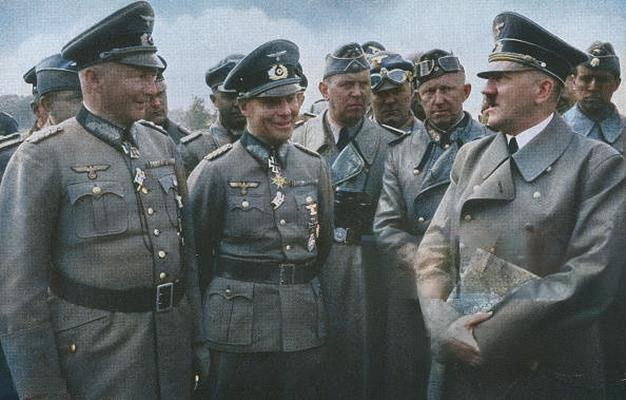"Hitler’s Blitzkrieg: How Methamphetamine Fueled the 35-Day Invasion of Poland
"Methamphetamine, tanks, and terror: Learn how Hitler’s Blitzkrieg and Nazi drug experiments led to Poland’s rapid downfall. The untold story of WWII’s darkest chapter."


Introduction: The Dawn of Lightning War
On September 1, 1939, Nazi Germany launched an invasion so swift and brutal that it redefined warfare forever. Poland, a nation of 35 million, collapsed in just 35 days under Hitler’s Blitzkrieg (“lightning war”) strategy. But beneath the roar of Panzer tanks and Stuka dive-bombers lay a darker secret: the systematic doping of soldiers with Pervitin, a methamphetamine that turned men into relentless, sleepless killers. This article dissects the tactical genius and pharmacological manipulation behind one of history’s most devastating military campaigns.
The Blitzkrieg Blueprint: Engineering Speed and Shock
Blitzkrieg wasn’t merely an attack—it was a psychological and logistical masterpiece designed to paralyze enemies. Its core pillars included:
Decapitation Strikes:
Luftwaffe bombers destroyed airfields, railways, and communication hubs in the first 48 hours, leaving Poland’s military blind and disorganized.
Example: The bombing of Wieluń on September 1 killed 1,200 civilians, signaling total war.
Panzer Divisions:
Germany deployed 2,600 tanks (including Panzer III and IV models) to punch through defenses. Unlike Poland’s cavalry, these armored units moved 30–50 km daily.
Encirclement (Kesselschlacht):
Mobile units bypassed strongholds, trapping Polish armies in pockets like the Battle of Bzura, where 170,000 troops surrendered.
Propaganda and Fear:
Films of burning villages and Stuka sirens (“Jericho Trumpets”) were broadcast globally to demoralize future targets like France.
Timeline of Terror: Poland’s 35-Day Collapse
Phase 1: The Opening Blows (Sept 1–7)
September 1: 1.5 million German troops cross the border. The battleship Schleswig-Holstein shells Westerplatte.
September 3: Britain and France declare war but fail to act (the “Phoney War”).
September 6: Kraków falls; Polish government flees to Lublin.
Phase 2: Total Encirclement (Sept 8–17)
September 8: Panzers reach Warsaw’s outskirts.
September 17: Soviet Union invades from the east per the Molotov-Ribbentrop Pact, splitting Poland.
Phase 3: Annihilation (Sept 18–Oct 6)
September 27: Warsaw surrenders after 1,150 Luftwaffe sorties.
October 6: Final Polish units capitulate. Death toll: 66,000 Poles, 16,000 Germans.
The Nazi Drug Pipeline: Pervitin and the Meth-Fueled Soldier
While Blitzkrieg relied on machinery, its human engine was chemically enhanced. The Nazi military distributed Pervitin—a methamphetamine tablet—to soldiers, pilots, and even officers.
How Pervitin Worked:
Dosage: 1–2 tablets (5–10 mg) every 3–6 hours.
Effects:
48+ hours of alertness.
Suppressed hunger, thirst, and fear.
Heightened aggression for close combat.
Addiction Risks: Paranoia, psychosis, and cardiac failure.
Shocking Numbers:
35 million Pervitin tablets were issued to troops between 1939–1940.
Tank crews consumed up to 30 pills during the Poland invasion.
Luftwaffe pilots dubbed it “Stuka pills” for marathon bombing runs.
Soldier Testimony:
“Pervitin kept us going for days. We felt invincible… until the crashes came.”
—Diary of a Wehrmacht infantryman, September 1939
Hitler’s Hypocrisy: The Führer’s Secret Drug Addiction
While Hitler preached racial purity, his body was a cocktail of narcotics. His personal physician, Dr. Theodor Morell, administered:
Eukodal (Oxycodone): Twice daily for chronic stomach pain.
Cocaine Drops: For “energy” before speeches (e.g., his 1940 Reichstag address).
Vitamultin Injections: Methamphetamine-laced tonics mixed with bull testosterone.
By 1943, Hitler was a skeletal addict, shaking uncontrollably and making erratic decisions like the Battle of the Bulge gamble.
Blitzkrieg’s Legacy: How Poland’s Fall Changed Warfare
Tactical Shift:
Allies adopted combined-arms tactics for D-Day (1944).
Modern armies still study Blitzkrieg for rapid-response strategies.
Ethical Nightmares:
Post-war trials revealed Nazi doctors tested drugs like D-IX (cocaine + meth) on concentration camp prisoners.
Today, militaries debate “performance enhancement” (e.g., modafinil use by pilots).
Poland’s Suffering:
6 million Poles (including 3 million Jews) died under occupation.
Warsaw was 85% destroyed; rebuilding took decades.
Conclusion: Speed, Drugs, and the Cost of Conquest
Hitler’s conquest of Poland was a Faustian bargain: 35 days of victory enabled by methamphetamine and moral bankruptcy. While Blitzkrieg revolutionized warfare, its reliance on chemical manipulation exposed the Third Reich’s fragility. The invasion’s legacy is a warning—innovation without humanity breeds destruction, not progress.